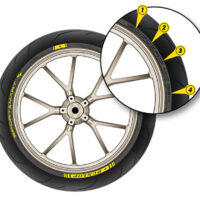Last Update: 28 October 2021

It’s exciting to get started in the world of motorcycle riding. There’s lots to learn and lots to discover with endless amounts of fun to be had! Insuring your motorcycle, or scooter, is a significant expense and you’ll want to make sure you’re getting a competitive rate. Equally important, however, are the details involved in the coverage you will arrange – so here’s our guide to motorcycle insurance – to make sure you’re safe.
Rules and guidelines vary between companies, between provinces, states and countries; but in general a smaller, less expensive motorcycle will cost less to insure, and so will an older rider.
Rule One: Airtight Quote
Always get an airtight insurance quote before putting money down on a motorcycle. Too often, people find out after buying that special motorcycle that was a real deal from a friend’s friend that the insurance cost will be extremely high, or that no insurance company wants to insure it at all. Some motorcycles are clearly high performance “Sport” motorcycles that will be expensive or difficult to insure and require a high level of experience and skill to ride. Motorcycles labelled “Rebuilt” are very difficult and expensive to insure. Be cautious of motorcycles that have after market frames or engines since these are also red flags to many insurers. Do your homework; educate yourself about the style of motorcycle you’re interested in, then find a broker who can explain in detail what the insurance implications are for the parameters you’ve set.
Rule Two: Give Honest Answers
Answer the questions posed by the broker/insurance representative in honest and clear detail. They will check later anyway, so don’t waste your time being evasive or vague. Number of traffic violations, cancellations of previous policies, accidents, other M licensed persons in the household: these and other details are extremely important to determine whether you qualify and how much you will have to pay. If you have had more than one traffic ticket (not including parking tickets) in the past three years, get a copy of your Drivers Abstract at the Ministry of Transportation before getting insurance quotes so that you know exactly what your record is.
Rule Three: Ask Questions
Remember when you shop for insurance that there are a lot of details to understand, and a good insurance broker will explain things well to you. You need to understand the details, so don’t be afraid to ask questions. There is no “perfect” coverage; the policy that suits you should be personalized. Some people need to have theft coverage on a relatively inexpensive motorcycle in order to feel comfortable, for example. Some people take Collision coverage off their motorcycles because they have a tight budget. Beyond comfort level and affordability issues, there are certain limits of coverage that are the minimum that a responsible broker will recommend, such as $1 million liability limit. A good insurance broker will guide you through this decision making process clearly, and will help to ensure you have reached a balance of coverage that fits you.
Rule Four: A Broker You Can Trust
While the cost of the insurance is obviously important, it’s also very important that you trust your broker and insurance company. Like any professional service that you purchase, you want to ensure that you are dealing with a brokerage that you are comfortable with and that will be there for you if you have questions, problems, or claims. You don’t want to be pressured to bring your car, house, etc., to that broker/agent just so that they will insure your motorcycle. You want them to understand motorcycle insurance; you don’t want to be insured with someone who is hesitant about insuring you, or who has an obvious aversion to motorcycles. If you get conflicting advice from brokers, be patient and make them explain themselves until you are fully satisfied that you understand. You, the customer, must demand nothing less.
Generally motorcycle riders are required by law to have the following insurance coverages on their motorcycle to get a plate and to ride legally: Liability, Accident Benefits, Uninsured Auto-mobile and Direct Compensation Property Damage. This is essentially the “basic” coverage that most insurance sales people quote.
The lowest liability limit that you should consider carrying for example, is $1 million. The amount of damage that you can do riding a motorcycle is significant, so you want to ensure you are adequately covered.
Accident Benefits covers you for Income Replacement, Medical Rehabilitation, Death and Funeral Expenses, and other things, subject to limits. It is very important to review those limits to confirm whether increasing those limits would be a good idea for you. A good insurance broker will walk you through this issue thoroughly and clearly. It is very important to be aware of these coverage limits at the outset; too often riders discover the limitations of their policies after a significant loss, which is too late.
Loss or Damage coverage for the motorcycle itself is quite straightforward, but again you want to ensure that you are being advised clearly by your broker. If you have financing on your motorcycle, you will be required to have Fire, Theft, and Collision by the bank/lien holder. Ask your broker what the cost difference is if you have higher or lower deductibles; sometimes lower deductibles cost only a little more than higher deductibles, and that is significant if your motorcycle is stolen or written off in an accident.
How Is Your Motorcycle Insurance Calculated?
If you understand how insurers set policy costs, you can take action to ensure your cost of cover is as low as possible. Generally speaking, the amount charged by an insurance company in premiums is a reflection of how likely any particular motorcyclist is to make a claim, as well as how expensive that claim is likely to be.
Some of the factors involved in these calculations you can’t do much about, such as your age and where you live. But there are others – say, taking a motorcycle safety course, the type of motorcycle you ride, and how much you use it – that you do have some influence over.
Bear in mind that different insurers treat these factors in different ways: this is why it’s always a good idea to shop around and get quotes from as wide a range of providers as possible. For example, some insurers may penalize you more than others for your age, or for having made claims in the last few years.
Your Age: One of the most significant factors in this calculation is age: the statistics show that young riders, for example, are more likely to be involved in accidents and to make claims than other age groups. This is why those aged between 17 and 25 generally face the highest premiums.
From you application form, an insurer can’t tell whether you are a cautious or reckless motorcyclist (unless you’ve made lots of claims before or have points on your licence), so it has to use statistical data from across all its customer base to work out what kind of a risk someone like you typically poses.
Your Gender: If insurers believe that one sex is more likely to be involved in accidents, or make claims, than the other, that group will face higher premiums. In some states or countries, this is often the case with male automobile drivers for example.
From December 2012, insurers will no longer be able to use gender to set rates, but this is not expected to have a significant impact on the motorcycle insurance market due to the fact that male riders outnumber female motorcyclists considerably.
However, like their car-owning counterparts, female motorcyclists are thought by many insurers to present a lower risk, which means their premiums do tend to be lower.
The Motorcycle You Ride: The make and model of motorcycle you are insuring has a large bearing on your insurance premiums.
Value: The more expensive it is, the more your motorcycle would cost to replace if stolen or written off in an accident – so the higher the premiums. A classic motorcycle, for example, may also cost more to repair, particularly if it is rare and the cost of spare parts is higher than for other makes and models. If, on the other hand, you own a beaten-up old scooter, don’t assume that just because your own motorcycle isn’t worth much, it will be cheap to cover: remember, insurance is not just for damage to your own ride, it is also designed to protect other road users against any accidents you could cause.
Power: The more powerful your motorcycle is, the more likely it is to be involved in accidents – and the more costly those accidents are likely to be. That’s why motorcycles with larger engines cost more to insure. If you modify your motorcycle to make it more powerful, you should inform your insurer: it will probably increase your premiums, but if you don’t tell them, your cover could be rendered invalid when you come to make a claim.
Desirability: If you own a particularly desirable motorcycle, your insurer may consider you at greater risk of theft and increase your premiums accordingly.
How You Use Your Motorcycle: If you use your ride for commuting as well as for social reasons, you are likely to pay more for cover as you’ll be riding more when the roads are busy. Your annual mileage also has a bearing: after all, the more time you spend on the road, the more likely you are to be involved in an accident.
The Security Measures You Take: The harder your motorcycle is to steal, the lower your premiums. If you can keep the motorcycle in a locked garage at night, this can help keep costs down, as can anti-theft measures such as ground anchors, immobilizers and motorcycle locks. Make sure any security devices you buy are recognised by the insurer you’re planning to use: otherwise you may not get a discount.
Where you Reside: Your postcode also has a bearing on the cost of insurance: if you live in a built-up area where the risk of accidents is greater, you’ll pay more – as you will if you live somewhere that has high recorded levels of motorcycle theft.
Your Riding Record and No-Claims Bonus: One of the most significant factors in calculating your cost of cover is your claims history, and whether you have any endorsements on your license. Here adding the success of a recognized motorcycle rider training course can be a big advantage to reducing your rate. Your insurer will ask for details of any claims in the past five years: you’ll have to state what the value of the claims were, and whether you were at fault. (Even if you weren’t at fault, the claim will still probably push up your premiums to some extent.) If you haven’t made any claims for a year or more, you should have some form of no-claims bonus. Most insurers will accept up to five years’ worth of no-claims, and this can result in discounts of up to 70 per cent with some providers.
Your Excess: The higher the voluntary excess (deductible) you agree to, the less your insurance will cost. For example, if you choose a voluntary excess of zero, your insurer knows that for every claim you make, it will have to pay the whole amount (less any compulsory excess).
But if you set your voluntary excess, your insurer knows that its potential pay-outs will be reduced, and also that you’ll be less likely to claim – any low-value claims will be uneconomical from your point of view.
Type of Coverage You Buy: Comprehensive insurance is normally more expensive than third-party or third-party, fire and theft, because your provider will potentially have to pay out in a greater range of circumstances.
With third-party cover, your insurer knows it will only be liable for damage caused by you to other road users – and not for damage caused to your own motorcycle or injuries you yourself sustain.
Who Else Is Insured to Ride Your Motorcycle? The named riders on your insurance policy can cause premiums to rise and fall. If you’re an experienced motorcycle rider, adding a young rider – such as your daughter who’s just passed her test – to your policy can cause the cost to rocket. Equally, if a young main rider adds a more experienced relative to their policy, it can reduce the costs. Most policies run for a 12 month period before you are given the option to renew or cancel and change to a different insurer.




